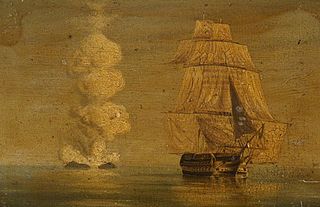Seven ships of the United Kingdom's Royal Navy have been called HMS Pallas. See Pallas (disambiguation) for various figures called "Pallas" in Greek mythology.

The United Kingdom, officially the United Kingdom of Great Britain and Northern Ireland but more commonly known as the UK or Britain, is a sovereign country lying off the north-western coast of the European mainland. The United Kingdom includes the island of Great Britain, the north-eastern part of the island of Ireland and many smaller islands. Northern Ireland is the only part of the United Kingdom that shares a land border with another sovereign state, the Republic of Ireland. Apart from this land border, the United Kingdom is surrounded by the Atlantic Ocean, with the North Sea to the east, the English Channel to the south and the Celtic Sea to the south-west, giving it the 12th-longest coastline in the world. The Irish Sea lies between Great Britain and Ireland. With an area of 242,500 square kilometres (93,600 sq mi), the United Kingdom is the 78th-largest sovereign state in the world. It is also the 22nd-most populous country, with an estimated 66.0 million inhabitants in 2017.

The Royal Navy (RN) is the United Kingdom's naval warfare force. Although warships were used by the English kings from the early medieval period, the first major maritime engagements were fought in the Hundred Years War against the Kingdom of France. The modern Royal Navy traces its origins to the early 16th century; the oldest of the UK's armed services, it is known as the Senior Service.

Greek mythology is the body of myths originally told by the ancient Greeks. These stories concern the origin and the nature of the world, the lives and activities of deities, heroes, and mythological creatures, and the origins and significance of the ancient Greeks' own cult and ritual practices. Modern scholars study the myths in an attempt to shed light on the religious and political institutions of ancient Greece and its civilization, and to gain understanding of the nature of myth-making itself.
- The first HMS Pallas (1757) was a 36-gun fifth rate launched at Deptford in 1757 and run aground in 1783.
- The second HMS Pallas (1793) was a 32-gun fifth rate launched at Woolwich Dockyard in 1793 and wrecked in 1798 on Mount Batten Point, near Plymouth.
- The third Pallas was a 38-gun fifth rate launched at Woolwich Dockyard in 1780 as HMS Minerva but renamed HMS Pallas when she was converted to a troopship in 1798. She was broken up in 1803.
- A Pallas was ordered but before construction started her name was changed and she was launched in 1803 as HMS Shannon.
- The fourth HMS Pallas was another 32-gun fifth rate launched at Plymouth in 1804 and wrecked in 1810 at the Firth of Forth.
- The fifth HMS Pallas (1816) was a 36-gun fifth rate launched at Portsmouth in 1816, and converted to a coal hulk in 1836. She was sold in 1862.
- The sixth HMS Pallas (1865) was an armoured corvette launched at Woolwich Dockyard in 1865, and sold in 1886.
- The seventh HMS Pallas (1890) was a Pearl-class second class cruiser launched at Portsmouth in 1890, and sold in 1906.
HMS Pallas was one of the three 36-gun Venus-class fifth-rate frigates of the Royal Navy. She was launched in 1757 and served until her loss in 1783.

Deptford, an area on the south bank of the River Thames in south-east London, is named after a ford of the River Ravensbourne. From the mid 16th century to the late 19th it was home to Deptford Dockyard, the first of the Royal Dockyards. This was a major shipbuilding dock and attracted Peter the Great to come and study shipbuilding. Deptford and the docks are associated with the knighting of Sir Francis Drake by Queen Elizabeth I aboard the Golden Hind, the legend of Sir Walter Raleigh laying down his cape for Elizabeth, Captain James Cook's third voyage aboard Resolution, and the mysterious murder of Christopher Marlowe in a house along Deptford Strand.

Woolwich Dockyard was an English naval dockyard along the river Thames at Woolwich in north-west Kent, where a large number of ships were built from the early 16th century until the late 19th century. William Camden called it 'the Mother Dock of all England'. By virtue of the size and quantity of vessels built there, Woolwich Dockyard is described as having been 'among the most important shipyards of seventeenth-century Europe'. During the Age of Sail, the yard continued to be used for shipbuilding and repair work more or less consistently; in the 1830s a specialist factory within the dockyard oversaw the introduction of steam power for ships of the Royal Navy. At its largest extent it filled a 56-acre site north of Woolwich Church Street, between Warspite Road and New Ferry Approach; 19th-century naval vessels were fast outgrowing the yard, however, and it eventually closed in 1869. The former dockyard area is now partly residential, partly industrial, with remnants of its historic past having been restored.








